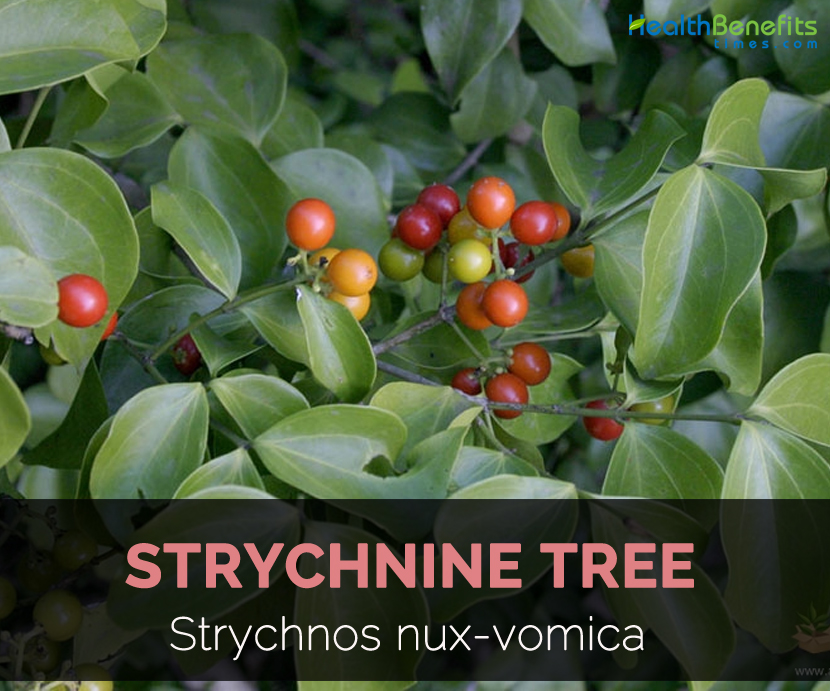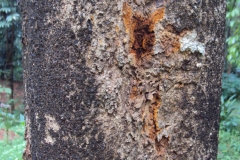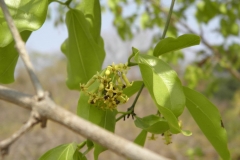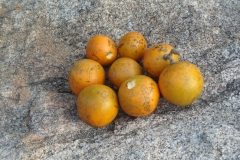It is a deciduous tree which is native to Southeast Asia and India. It is a medium sized tree which grows in open habitats. Leaves are ovate measuring 2–3.5 inches (5.1–8.9 cm) in size. The various parts of plant especially seeds and bark contains various indications in folklore and traditional medicines of different countries. It is a great source of highly poisonous and intensely bitter alkaloids strychnine and brucine acquired from seeds inside the round and green to orange fruit.
The plant is used in formulating more than 60 Indian systems of medicine, 30 of which is used for treating disorders of vata dosha. The various parts of plant are rich in indole alkaloids such as strychnine and brucine liable for various therapeutic purposes.
Plant
Strychnos nux-vomica is a medium sized tree with short, crooked and thick trunk. Wood is close grained, hard white and dense. Branches are irregular and ash colored. Young shoots are deep green with a shiny coat. Leaves are arranged opposite decussate, short stalked and oval shaped with shiny coat and are smooth on both sides. Leaves are 4 inches (10 cm) long and 3 inches (7.6 cm) wide. Flowers are small, funnel shaped and pale green in color with foul smell which blooms usually in cold season. Flowers give way to yellow fruits with soft and white (jelly-like) white pulp that contains five seeds covered with soft and woolly substance. Seeds are flattened disk covered with hairs that radiates from center of the sides.
History
It is believed that in 323 B.C., the death of Alexander was due to the intake of wine that contains strychnine. Nux vomica tree nut was used for medicinal purposes at the times of mid-16th century.
Valeruis Cordus was the first German physician and botanist who have written about nux vomica around this time. Then nut was used as an antidote for plague, worms, hysteria, rabies, rheumatism and gout by Germans. Strychnine was also used in rat poisons and also used by veterinarians as a stimulant in smaller doses.
Health Benefits of Strychnos nux-vomica
Discussed below are some health benefits of Strychnos nux vomica:
- Motion sickness
Nux vomica is helpful for motion sickness if one have severe nausea with difficulty vomiting and intense headache at back of head and eye. Still scientific studies are required to improve motion sickness.
- Prevent constipation
Nux vomica is a cure for constipation. It acts as a laxative and helps to break constipation. But research is still needed to assure it is effective for constipation.
- Treat flu
Influenza also known as flu could be helped with the use of nux vomica. It is effective for gastric flus with diarrhea and vomiting. Studies shows that stem and bark contains high level of flavonoids and have antiviral effects that make it effective to combat viral diseases such as flu. The homeopathic remedy comes from seeds not the stem bark.
- Treatment for urinary tract infection
Nux vomica is useful for treating urinary tract infections when these symptoms occur such as irritable bladder with constant need to urinate but passes only small amounts. The cramping pain or burning may be felt in bladder area with itching sensation in urethra with passing of urine. The person feels impatient, irritable and chilly. The symptoms could be relieved by hot baths and other forms of warmth.
- Cure for insomnia
Insomnia is a sleep disorder which affects about 10 percent of the adults. Insomnia is caused due to anger, anxiety, irritability, use of alcohol, caffeine and drugs. The study shows that nux vomica has positive impact on REM sleep but further research is still required for confirmation.
- Reduce back pain
Strychnos nux-vomica is useful for muscle cramps and constricting pains in the back. The discomfort is worsened due to cold and provides relief from warmth. Pain worsens at night and backache is worse at the time of constipation.
Traditional uses
- It is used to treat neuralgic and paralytic affections, itching, dyspepsia, joint pain, urinary disorders, epilepsy, emotional disorders, dysentery, insomnia and rheumatism.
- In India, fruits are used as tonic, appetizer, antipyretic and aphrodisiac.
- It is used as a cure for blood diseases, leucoderma, ringworm, itching, ulcer, piles, urinary disorders, anemia, limb weakness and lumbago.
- Juice of stem and root barks are used to treat cholera, intermittent fevers and acute dysentery.
- Use the bark infusion internally for treating epilepsy or apply it externally for leprotics and ulcers.
- Apply the leaves externally as a poultice for wounds, ulcers (in formation of maggots).
- It is a cure for trauma, swelling pain, bone fracture, rheumatoid arthritis, facial nerve paralysis and myasthenia gravis.
- It is a cure in chronic dysentery, epilepsy, paralytic and neuralgic disorders, hydrophobia and rheumatic arthritis.
- It is used for treating constipation, abdominal pain, insomnia, heartburn, upset stomach, depression, circulatory problems, nervous conditions, migraine, depression and problems associated to respiratory diseases and menopause.
Precautions
- It may cause some side effects such as anxiety, restlessness, dizziness, spasms of jaw and neck muscles, neck and back stiffness, seizures, convulsions, liver failure, breathing problems and death.
- Avoid by breastfeeding mothers and pregnant women.
- In case of nux vomica poisoning, seek for immediate medical attention.
Other facts
- The tree lives up to the lifespan of 50 to 60 years.
- The tree takes 15 to 20 years to initiate flowering.
References:
https://www.itis.gov/servlet/SingleRpt/SingleRpt?search_topic=TSN&search_value=505984#null
Comments
comments
| Strychnine tree Quick Facts | |
|---|---|
| Name: | Strychnine tree |
| Scientific Name: | Strychnos nux-vomica |
| Origin | India and to southeast Asia. |
| Colors | Orange-red |
| Shapes | Rough, glossy orange, 4‐5 cm wide |
| Flesh colors | White or pale yellow |
| Taste | Bitter |



